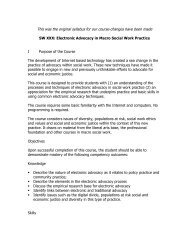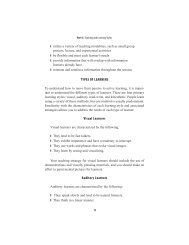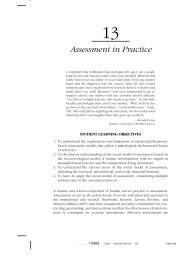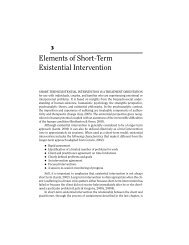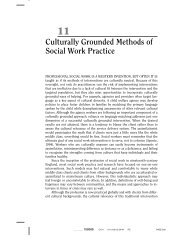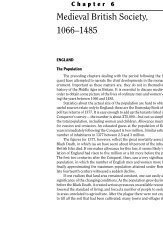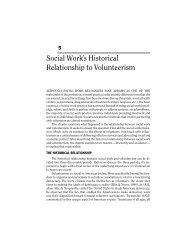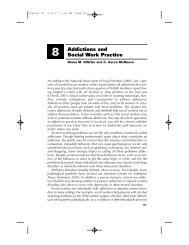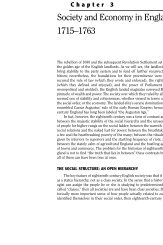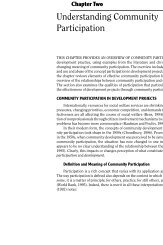Chapter 2 Self-Awareness, Critical Reflectivity, and ... - Lyceum Books
Chapter 2 Self-Awareness, Critical Reflectivity, and ... - Lyceum Books
Chapter 2 Self-Awareness, Critical Reflectivity, and ... - Lyceum Books
Create successful ePaper yourself
Turn your PDF publications into a flip-book with our unique Google optimized e-Paper software.
<strong>Chapter</strong> 02 2/11/08 12:10 PM Page 23<br />
<strong>Self</strong>-<strong>Awareness</strong>, <strong>Critical</strong> <strong>Reflectivity</strong>, <strong>and</strong> Identity 23<br />
3. What do I know about how to relate to <strong>and</strong> interpret the behavior of<br />
others who occupy social locations (i.e., class, gender, race/ethnicity,<br />
sexual orientation, ability, religion) that are similar to, as well as different<br />
from, my own?<br />
4. What have I learned about how to interpret the behavior of people<br />
whose race/ethnicity, sexual orientation, ability, or religion is different<br />
from my own? What if I add class <strong>and</strong> gender/sex to the equation?<br />
5. What do I know about my conscious intentions when I interact with a<br />
client who is African American, Latino/Latina, Native American, Asian<br />
American, biracial or multiracial, or European American; refugees <strong>and</strong><br />
other immigrants; people who are gay, lesbian, bisexual, transgender, or<br />
intersex; <strong>and</strong> people with disabilities?<br />
6. Why do the consequences or outcomes of my actions not fit with or<br />
match my good intentions? (Kondrat, 1999)<br />
These questions facilitate a process of reflection that allows for critical selfreflectivity.<br />
Box 2.2 provides an example of a situation in which this reflection<br />
was useful to a social work intern in her work.<br />
Box 2.2 Reflections of a Social Work Intern<br />
Carrie, a white social work intern in her mid-twenties, is completing<br />
her practicum in a community-based social service agency. She has<br />
been assigned several cases throughout the academic year. As she approaches<br />
her final two months of field work, she is asked to reflect on<br />
her experiences in preparation for the end-of-term field evaluation.Carrie<br />
was eager to start her internship <strong>and</strong> chose to work in an urban<br />
agency that had a diverse client population. Having been raised in a<br />
family that believed that all people should be treated equally, <strong>and</strong> having<br />
lived most of her life in a small rural all-white community, Carrie<br />
was looking forward to the challenges of an urban experience.<br />
Carrie’s agency is located in an active urban community that is<br />
home to a growing number of racial/ethnic groups. At this community<br />
service organization, clients can find a diverse range of services all<br />
under one roof.The rapid growth of the community, however, has required<br />
changes within the agency, which is now often short staffed.<br />
Although clients from various racial/ethnic groups are served, the<br />
agency staff is primarily composed of white middle-class women. Carrie<br />
looks to her colleagues <strong>and</strong> supervisor to underst<strong>and</strong> agency protocol<br />
in this rapidly changing environment.<br />
Carrie has demonstrated her willingness to actively engage in reflective<br />
practice through the use of supervision, journal writing, <strong>and</strong><br />
field seminar discussions. Her weekly meetings with her supervisor<br />
have been very task focused, <strong>and</strong> she has received positive feedback<br />
about her performance. While reviewing her cases thus far, however,



